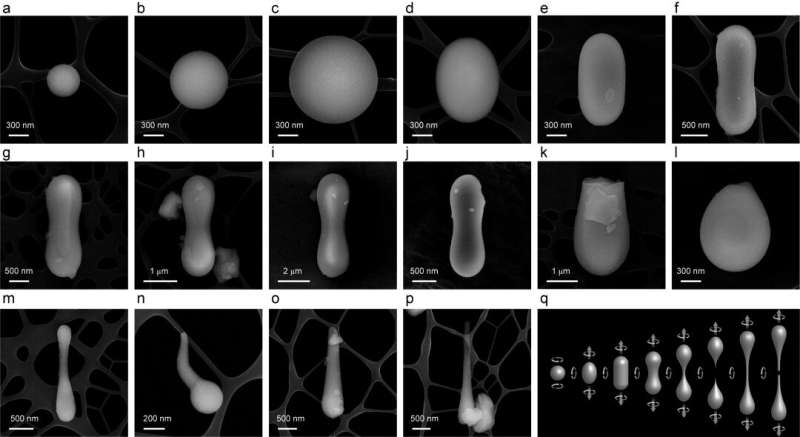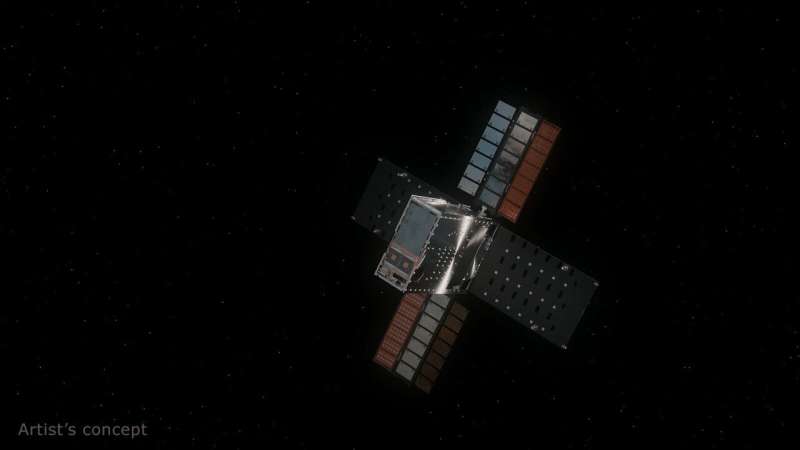LiveEO and Capella Space offer fast, high-res SAR imaging to asset managers
Tuesday, 16 May 2023 10:12 LiveEO, a market leader in Earth observation analytics and solutions for high-value infrastructure and energy asset monitoring, has announced a partnership with Capella Space, the world's leading provider of high-resolution synthetic aperture radar (SAR) imagery. As the first certified Capella Analytics Partner, LiveEO will integrate all-weather, 24/7 SAR imagery from Capella Space into its adva
LiveEO, a market leader in Earth observation analytics and solutions for high-value infrastructure and energy asset monitoring, has announced a partnership with Capella Space, the world's leading provider of high-resolution synthetic aperture radar (SAR) imagery. As the first certified Capella Analytics Partner, LiveEO will integrate all-weather, 24/7 SAR imagery from Capella Space into its adva Research announcement for technology development leveraging ISS is open for concepts
Tuesday, 16 May 2023 10:12 The International Space Station National Laboratory is soliciting flight concepts for technology development that would utilize the space-based environment of the orbiting laboratory.
This solicitation, "Technology Advancement and Applied Research Leveraging the ISS National Lab," is open to a broad range of technology areas, including chemical and material synthesis in space, bonding, tra
The International Space Station National Laboratory is soliciting flight concepts for technology development that would utilize the space-based environment of the orbiting laboratory.
This solicitation, "Technology Advancement and Applied Research Leveraging the ISS National Lab," is open to a broad range of technology areas, including chemical and material synthesis in space, bonding, tra InVADER mission to test its robotic laser divebot on a deep-sea expedition
Tuesday, 16 May 2023 10:12 A team of scientists and engineers from the SETI Institute, Impossible Sensing, NASA JPL, and other institutions will test their innovative robotic laser system on a deep-sea expedition aboard the E/V Nautilus. The mission, called InVADER (In-situ Vent Analysis Divebot for Exobiology Research), aims to advance technologies to explore, characterize and sample the seabed here on Earth. In particul
A team of scientists and engineers from the SETI Institute, Impossible Sensing, NASA JPL, and other institutions will test their innovative robotic laser system on a deep-sea expedition aboard the E/V Nautilus. The mission, called InVADER (In-situ Vent Analysis Divebot for Exobiology Research), aims to advance technologies to explore, characterize and sample the seabed here on Earth. In particul New deal inked to space test meta-optical surfaces
Tuesday, 16 May 2023 10:12 A new engineering study has been commissioned by the European Space Agency (under PECS, the Program for European Cooperating States), to prove the reliability of meta-optical elements for space use in a collaboration between the ESA, Bulgarian start-up company LaboraXpert and TMOS, the Australian Research Council Centre of Excellence for Transformative Meta-Optical Systems.
In the first st
A new engineering study has been commissioned by the European Space Agency (under PECS, the Program for European Cooperating States), to prove the reliability of meta-optical elements for space use in a collaboration between the ESA, Bulgarian start-up company LaboraXpert and TMOS, the Australian Research Council Centre of Excellence for Transformative Meta-Optical Systems.
In the first st EarthCARE, when a satellite sheds light on the clouds
Tuesday, 16 May 2023 10:12 EarthCARE is an important new satellite designed and built by Airbus to help scientists better understand climate change on clouds, aerosols and radiation. Under construction for the European Space Agency (ESA), Airbus successfully completed the Electro-Magnetic Compatibility tests in April 2023 and now this latest ESA "Earth Explorer" satellite is getting closer to launch next year.
The i
EarthCARE is an important new satellite designed and built by Airbus to help scientists better understand climate change on clouds, aerosols and radiation. Under construction for the European Space Agency (ESA), Airbus successfully completed the Electro-Magnetic Compatibility tests in April 2023 and now this latest ESA "Earth Explorer" satellite is getting closer to launch next year.
The i Axiom Space's second crewed mission gets green light
Tuesday, 16 May 2023 10:12 Axiom Space's second, entirely private space mission is on track for a Sunday launch aboard a SpaceX Dragon spacecraft to the International Space Station from Kennedy Space Center in Florida, officials said Monday.
The launch is planned for 5:37 p.m. EDT from Launch Complex 39A. Should bad weather set in, controllers could try again the next day.
If the weather does not cooperate
Axiom Space's second, entirely private space mission is on track for a Sunday launch aboard a SpaceX Dragon spacecraft to the International Space Station from Kennedy Space Center in Florida, officials said Monday.
The launch is planned for 5:37 p.m. EDT from Launch Complex 39A. Should bad weather set in, controllers could try again the next day.
If the weather does not cooperate NASA Gears Up to Train Artemis II crew for Moon mission
Tuesday, 16 May 2023 10:12 The four astronauts who will fly on NASA's Artemis II flight are getting ready to begin their training in June, as NASA prepares for the first crewed mission on the agency's path to establishing a long-term presence at the Moon for science and exploration.
NASA astronauts Reid Wiseman, Victor Glover, Christina Hammock Koch, and CSA (Canadian Space Agency) astronaut Jeremy Hansen will compl
The four astronauts who will fly on NASA's Artemis II flight are getting ready to begin their training in June, as NASA prepares for the first crewed mission on the agency's path to establishing a long-term presence at the Moon for science and exploration.
NASA astronauts Reid Wiseman, Victor Glover, Christina Hammock Koch, and CSA (Canadian Space Agency) astronaut Jeremy Hansen will compl NASA's Juno mission closing in on Io
Tuesday, 16 May 2023 10:12 NASA's Juno spacecraft will fly past Jupiter's volcanic moon Io on Tuesday, May 16, and then the gas giant itself soon after. The flyby of the Jovian moon will be the closest to date, at an altitude of about 22,060 miles (35,500 kilometers). Now in the third year of its extended mission to investigate the interior of Jupiter, the solar-powered spacecraft will also explore the ring system where s
NASA's Juno spacecraft will fly past Jupiter's volcanic moon Io on Tuesday, May 16, and then the gas giant itself soon after. The flyby of the Jovian moon will be the closest to date, at an altitude of about 22,060 miles (35,500 kilometers). Now in the third year of its extended mission to investigate the interior of Jupiter, the solar-powered spacecraft will also explore the ring system where s Astra, Momentus face cash crunch
Tuesday, 16 May 2023 09:09
Two startups that went public through SPAC mergers say they are pressing ahead with plans despite warnings that they are running perilously low on cash.
SpaceX has narrow window for Ax-2 launch
Tuesday, 16 May 2023 08:06
SpaceX and Axiom Space will have only two opportunities this month to launch a private astronaut mission to the International Space Station before having to wait potentially several months before getting another shot.
Euclid launch kit link
Tuesday, 16 May 2023 06:38
Euclid launch kit
Interactive infographics and background information to prepare for Euclid’s launch
Space Force general: ‘No pushback’ from Congress on 2024 budget priorities
Monday, 15 May 2023 19:22
Italy awards $256 million contract for 2026 in-orbit servicing mission
Monday, 15 May 2023 19:04
Italy’s space agency has awarded local companies 235 million euros ($256 million) in pandemic relief funds for an in-orbit servicing demo in 2026, the group’s leader Thales Alenia Space announced May 15.
Glass fibers in lunar regolith could help build structures on the moon
Monday, 15 May 2023 17:24
Through the Artemis Program, NASA plans to send the first astronauts to the moon in over 50 years. Before the decade is over, this program aims to establish the infrastructure that will allow for a "sustained program of lunar exploration and development." The European Space Agency (ESA) also has big plans, which include the creation of a moon Village that will serve as a spiritual successor to the International Space Station (ISS). China and Roscosmos also came together in June 2021 to announce that they would build the International Lunar Research Station (ILRS) around the lunar south pole.
In all cases, space agencies plan to harvest local resources to meet their construction and long-term needs—a process known as in-situ resource utilization (ISRU).
NASA calls end to Lunar Flashlight mission after some tech successes
Monday, 15 May 2023 15:19
While the CubeSat couldn't reach the lunar South Pole to help seek ice, it fulfilled several technology goals that will empower future missions for the benefit of humanity.
NASA's Lunar Flashlight launched on Dec. 11, 2022, to demonstrate several new technologies, with an ultimate goal to seek out surface ice in the permanently shadowed craters of the moon's South Pole. Since then, the briefcase-size satellite's miniaturized propulsion system—the first of its kind ever flown—proved unable to generate enough thrust to get into lunar orbit, despite months of effort by the operations team.

